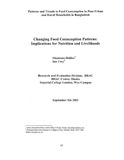| dc.contributor.author | Halder, Shantana R | |
| dc.contributor.author | Urey, Ian | |
| dc.date.accessioned | 2020-01-22T03:52:29Z | |
| dc.date.available | 2020-01-22T03:52:29Z | |
| dc.date.issued | 2003-09 | |
| dc.identifier.citation | Halder, S. R., & Urey, I. (2003, September). Changing food consumption patterns: implications for nutrition and livelihoods. Research Reports (2003): Economic Studies, Vol – XX, 17–121. | en_US |
| dc.identifier.uri | http://hdl.handle.net/10361/13657 | |
| dc.description.abstract | This report presents a review results on the trends and patterns in food intake and
nutritional status of the poor rural and urban households of Bangladesh during the
period 1991-2000. It then looks at the socio-economic changes that have occurred
during the last decade that have affected the food consumption pattern and the
development of the food system. The 1990s was marked by a substantial increase in
food production, however, the country is yet to achieve desired nutritional levels.
The 1990s also saw substantial economic growth, with an associated decline in the
incidence of both absolute poverty and extreme poverty. Parallel with food production
and economic growth, poverty reduction, Bangladesh achieved notable reductions in
child malnutrition rates during the nineties although percentage of malnourished
children of the poor families was over 60%. Thus poor households, rural and urban
alike, did not benefit proportionately from increased food production and the economic
growth that the country achieved during the nineties. In 2000 the food intake of the
poor was as low and imbalanced as it was in 1991.
With the changes in food production and consumption, the total food system in
Bangladesh is also changing. The growth of urban middle-income groups due to
economic growth has created the demand for higher value products such as livestock
products, fruits and vegetables. Increasing urbanisation and industrialisation has also
encouraged market expansion for food products and increased market dependence for
certain households.
Transport infrastructure improved in the last decade. A more integrated food
transportation network has developed which have increased the length of supply
chains and the volume of food supplied. The integration of Bangladesh with the global
economy expanded both the legal and illegal trade which have implications on the
availability of food produce, dietary diversity, price stabilisation, and employment
opportunities in the expanding sector. | en_US |
| dc.language.iso | en | en_US |
| dc.publisher | BRAC Research and Evaluation Division (RED) | en_US |
| dc.subject | Food consumption | en_US |
| dc.subject | Nutrition | en_US |
| dc.subject | Livelihoods | en_US |
| dc.subject | Urban poor | en_US |
| dc.subject | Rural Bangladesh | en_US |
| dc.subject.lcsh | Food consumption --Bangladesh. | |
| dc.subject.lcsh | Malnutrition | |
| dc.subject.lcsh | Household surveys. | |
| dc.title | Changing food consumption patterns: implications for nutrition and livelihoods | en_US |
| dc.type | Research report | en_US |

